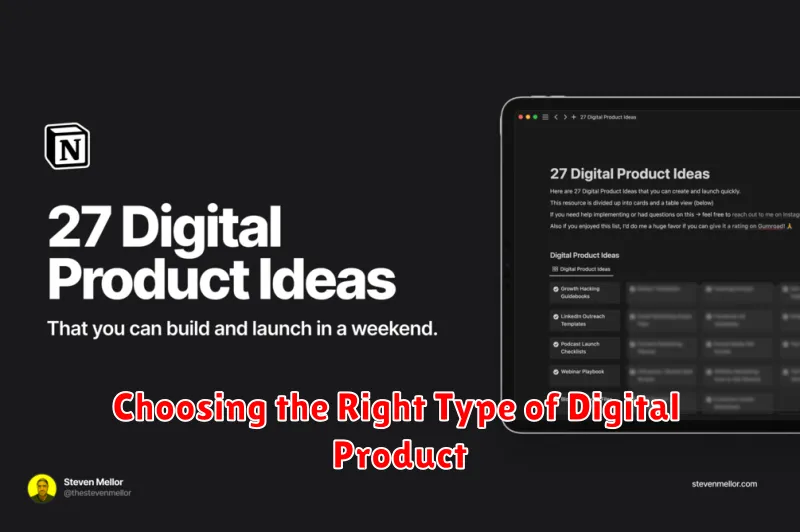Launching a successful digital product online requires a strategic approach. This comprehensive guide will walk you through each crucial step, from identifying your target audience and developing a compelling marketing strategy to choosing the right e-commerce platform and optimizing your sales funnel. Learn how to effectively market your digital product, manage customer relationships, and ultimately increase your sales and build a thriving online business. We’ll cover essential aspects like pricing strategies, content marketing, and customer service to ensure your digital product launch is a resounding success.
Choosing the Right Type of Digital Product

Selecting the right digital product is crucial for a successful online launch. Your choice should align with your skills, market demand, and business goals.
Consider various options: eBooks offer in-depth knowledge on a specific topic; online courses provide structured learning experiences; templates (like website templates or spreadsheets) offer ready-made solutions; stock photos or videos cater to visual content needs; and software or apps provide functional tools.
Thorough market research is essential. Identify your target audience and assess their needs and preferences. Analyze existing products and identify gaps you can fill with a unique offering. Consider pricing strategies and potential profit margins for each product type.
Ultimately, choose a product you’re passionate about and confident you can deliver high quality. This passion will translate into a better product and a more successful launch.
Validating Your Idea Before Creation
Before investing significant time and resources into creating your digital product, validating your idea is crucial. This involves confirming that there’s genuine market demand and that your product solves a real problem for a specific target audience. Skipping this step can lead to wasted effort and financial losses.
Several methods exist for idea validation. Market research, including surveys and competitor analysis, helps understand existing solutions and potential customer needs. Testing your concept, perhaps with a Minimum Viable Product (MVP), allows you to gather direct feedback and iterate based on real user interaction. Analyzing the potential profitability ensures that the product’s projected revenue surpasses development and marketing costs.
Gathering feedback from potential customers is paramount. Use surveys, interviews, and focus groups to understand their needs, pain points, and willingness to pay. This will inform your product design and marketing strategy, improving the chances of success. Analyzing your competition highlights existing solutions and potential market gaps, enabling you to offer a unique value proposition.
By diligently validating your idea, you significantly reduce the risk of launching a product that fails to resonate with your target audience. This proactive approach ensures your resources are invested wisely, maximizing your chances of a successful online launch.
How to Create and Package the Product
Creating a successful digital product begins with a strong concept. Clearly define your product’s purpose, target audience, and unique value proposition. Thorough market research is crucial to ensure demand and avoid unnecessary development.
Next, focus on development. This involves creating high-quality content, ensuring functionality, and addressing any technical aspects. For example, if you are creating an eBook, invest in professional editing and formatting. If it’s a software, prioritize usability and a seamless user experience.
Packaging your digital product is equally important. This includes designing appealing visuals, writing compelling descriptions, and creating a user-friendly delivery system. A well-designed package will enhance your product’s perceived value and improve the customer experience.
Finally, consider offering various pricing tiers to cater to different customer needs and budgets. This can include a basic version, a premium version with added features, or even a subscription model. Strategically pricing your product maximizes revenue potential.
Building a Launch List with Email Marketing
A strong email list is crucial for a successful digital product launch. Building your list before launch allows you to directly reach potential customers who have shown interest in your product or niche. This targeted approach maximizes your marketing efforts and minimizes wasted resources.
Several strategies effectively build your launch list. Lead magnets, such as free ebooks, checklists, or webinars related to your product, incentivize sign-ups. Website opt-in forms strategically placed on your website capture email addresses from interested visitors. Social media promotions, accompanied by compelling calls-to-action, can also drive sign-ups.
Segmenting your email list is equally important. Categorize subscribers based on interests or demographics to personalize your messaging. Tailored emails resonate more strongly, improving engagement and conversion rates. This segmentation allows for more efficient and effective campaign delivery.
Finally, remember to use a reliable email marketing platform. This will allow for automation, detailed analytics, and streamlined communication with your list. Effective email marketing automation can nurture leads before, during, and after your launch, enhancing your overall success.
Creating a High-Converting Sales Page

A high-converting sales page is crucial for successfully launching a digital product. It needs to clearly communicate the value of your product and persuade visitors to make a purchase.
Start by crafting a compelling headline that immediately grabs attention and highlights the key benefit. Use strong, action-oriented language.
Next, focus on addressing your target audience’s pain points and demonstrating how your product provides a solution. Use clear and concise language, avoiding jargon.
Include social proof such as testimonials, case studies, or reviews to build trust and credibility. Showcase the positive results achieved by other users.
A strong call to action (CTA) is essential. Make it prominent, clear, and easy to find. Use compelling verbs like “Buy Now,” “Get Instant Access,” or “Download Today.”
Finally, optimize your sales page for conversions. This involves A/B testing different elements, tracking key metrics, and making data-driven improvements. Continuously analyze and refine your page based on performance.
Remember, a well-designed sales page is an investment in your product’s success. By focusing on clarity, value proposition, and a strong CTA, you can significantly increase your conversion rates and boost your sales.
Using Social Media to Build Pre-Launch Hype
Social media is a powerful tool for generating pre-launch buzz. Platforms like Instagram, Facebook, Twitter, and TikTok offer diverse ways to connect with your target audience and build anticipation for your digital product.
Strategic content is key. Share engaging teasers, behind-the-scenes glimpses, and snippets of your product’s value proposition. Run contests and giveaways to incentivize engagement and build your email list.
Influencer marketing can significantly amplify your reach. Partnering with relevant influencers can expose your product to a wider, more engaged audience, creating a wave of excitement before launch.
Paid advertising on social media platforms allows you to target specific demographics and interests, ensuring your pre-launch message reaches the right people. Careful targeting and compelling ad creatives are crucial for maximizing ROI.
Consistent posting and interactive communication are essential. Respond to comments and messages promptly, fostering a sense of community and building relationships with potential customers. This helps cultivate trust and excitement before your product’s official release.
By utilizing these strategies effectively, you can build significant pre-launch hype, transforming anticipation into strong sales upon your digital product’s launch.
Automating Delivery and Access
Automating the delivery and access to your digital product is crucial for a smooth launch and efficient post-launch operation. This involves using reliable systems to manage the distribution and access control of your product.
Consider using a digital delivery platform, such as a dedicated e-commerce platform or a service like Gumroad or SendOwl. These platforms handle the secure delivery of your product, often with features for managing licenses and access control.
For access control, implement a system using unique user identifiers and passwords, or leverage features offered by your chosen delivery platform. This ensures only authorized users can access your digital product. Consider adding features like email verification to improve security.
Automating this process saves you valuable time and resources, allowing you to focus on other aspects of your business. A well-automated system also ensures a seamless customer experience, reducing friction and increasing satisfaction.
Measuring Results and Scaling Post-Launch
Post-launch, continuous monitoring is crucial. Track key metrics like website traffic, conversion rates, customer acquisition cost (CAC), and customer lifetime value (CLTV). Use analytics tools like Google Analytics to gain valuable insights.
Analyzing these metrics helps understand what’s working and what’s not. Identify areas for improvement and optimization. For example, low conversion rates might indicate a problem with your website’s design or your marketing messaging.
Based on your analysis, you can scale your operations. This might involve increasing your marketing budget, expanding your team, improving your product, or targeting new customer segments. Iterative improvements based on data analysis are key to long-term success.
Prioritize customer feedback. Actively solicit reviews and testimonials. Use this feedback to refine your product and marketing strategies. This iterative process of measuring, analyzing, and adapting is the foundation for sustainable growth.
Remember, scaling sustainably is paramount. Avoid rapid expansion that outpaces your infrastructure or resources. Focus on controlled growth, ensuring profitability and customer satisfaction at every stage.

